
그린월은 벽면녹화라는 뜻으로 네덜란드, 프랑스, 스웨덴 등을 중심으로 한 유럽권에서는 20여년전부터 스마트팜 벽면녹화 등을 발전시켜 왔고, 현재는 관공서, 기업체, 병원, 호텔 등과 같은 건물의 실내,외 벽면 녹화가 활발하게 이루어지고 있습니다. 현대인들은 하루 생활중 실내에서의 생활이 80% 이상을 차지한다고 한 연구기관은 밝혔고, 최근 코로나와 초미세먼지 등의 문제로 실내에서의 생활은 그 이상을 차지할 것으로 예측되며, 따라서 실내 벽면녹화는 상당한 관심사로 등장하였습니다.
Green wall means wall greening, and in Europe, mainly in the Netherlands, France, and Sweden, smart farm wall greening has been developed since 20 years ago, and currently, indoor and outdoor wall greening of buildings such as government offices, businesses, hospitals, hotels, etc. is actively being carried out. According to a research institute, modern people spend more than 80% of their daily life indoors, and it is predicted that it will be even more due to recent problems such as corona and ultra-fine dust, so indoor wall recording has emerged as a significant concern.
벽면녹화는 공기정화, 온·습도 조절, 심신치유, 미관향상 등 여러 효과가 매우 높습니다.
Greenwall has many benefits, including air purification, temperature and humidity control, mental and physical healing, and aesthetic enhancement.
[공기정화식물] Air Purifying Plants
실내 오염물질로 꼽히는 포름알데히드, 일산화탄소, 암모니아, 벤젠, 톨루엔 등의 휘발성유기화합물을 제거하며, 미세먼지 정화, 실내 습도 조절 등의 역할을 합니다. 이 외에도 식물에 따라 냄새 제거용, 전자파 차단용, 소음 제거용으로도 활용되기도 합니다.
It removes volatile organic compounds such as formaldehyde, carbon monoxide, ammonia, benzene, and toluene, which are common indoor pollutants, purifies fine dust, and regulates indoor humidity. Depending on the plant, it can also be used to remove odors, block electromagnetic waves, and reduce noise.

스킨답서스
Epipremnum
일산화탄소 제거
Remove carbon monoxide
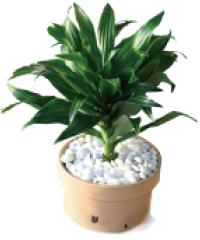
드라세나 콤팩타
Dracaena compacta
미세먼지 제거
Remove fine dust

율마
Cupressus
공기정화, 살균 및 방충식물
Air purifying, sanitizing, and insect repellent plants
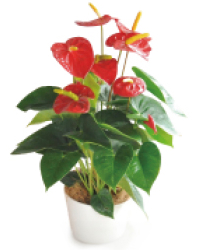
안스리움
anthurium
일산화탄소, 암모니아 가스 제거
Removes carbon monoxide and ammonia gas
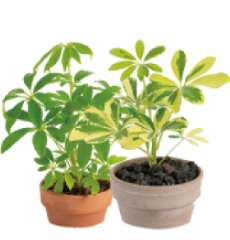
미니/무늬 홍콩야자
Dwarf umbrella tree
포름알데히드 제거
Remove formaldehyde
[식물의 공기 정화 방법] How plants clean the air
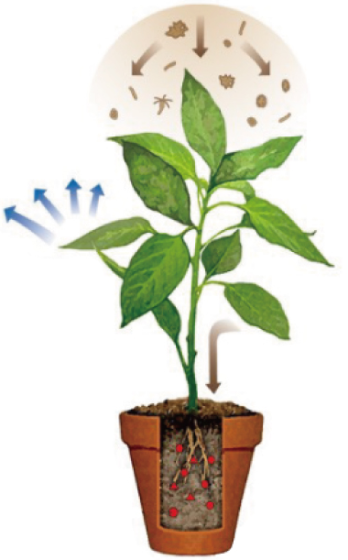
공기중 오염물질(포름알데히드, 크실렌 등)이 잎의 가공을 통해 흡수
Airborne pollutants (formaldehyde, xylene, etc.) are absorbed through processing of leaves
잎의 증산작용에 의해 수증기 방출
Leaves release water vapor by transpiration
잎의 증산작용에 의해 압력 차이 발생, 오염물질이 토양으로 이동
Leaf transpiration creates a pressure differential, moving contaminants into the soil
뿌리 미생물에 의한 오염물질 분해
Contaminant breakdown by root microbes
[공기정화식물의 분류] Classification of air purifying plants
공기정화식물은 흡수유해물질, 배출 물질, 재배 방법에 따라 나눌 수 있습니다.
Air purifying plants can be categorized by the pollutants they absorb, the pollutants they emit, and the way they are grown.
포름알데히드 제거에 좋은 식물
Plants good for removing formaldehyde
보스턴고사리 Boston fern
아이비 Ivy
암모니아 제거에 좋은 식물
Plants good for removing ammonia
관음죽 Broadleaf lady palm
국화 Chrysanthemum
맥문동 Lily turf
벤자민고무나무 Weeping fig
이산화탄소, 일산화탄소 제거에 좋은 식물
Plants good for removing carbon dioxide and carbon monoxide
대나무야자 Bamboo palm
산세베리아 Sansevieria
안스리움 Anthurium
화학물질 제거에 좋은 식물
Plants good for removing chemical
드라세나 Dracena
맛상게아나(행운목) Dracaena fragrans
마코야나 Calathea makoyana
알로카시아 Alocasia
증산작용이 좋은 식물
Plants with good transpiration
테이블야자 Chamaedorea elegans
아레카 야자(습도조절) Areca palm(Controls Humidity)
홍콩야자 Schefflera
공기정화, 살균 및 방충식물
Air purifying, sanitizing, and insect repellent plants
율마 Cupressus
[공기정화식물의 분류] Classification of air purifying plants
1980년대 식물이 휘발성유기화합물(VOC) 정화 능력이 있다는 사실이 밝혀지기 시작하였습니다. 미항공우주국(NASA)은 우주선의 밀폐된 공간 안에서 생태적 생명유지시스템 실현을 위한 연구를 수행하였습니다. 이 연구 중 하나로 밀폐된 실내에서 발생하는 각종 오염 물질을 제거하고 실내 공기를 정화하여 내부의 생명체가 건강하게 생활할 수 있도록 하기 위한 실험이 ‘나사의 공기 정화 연구 : 실내공기오염물질 감소를 위한 실내 조경식물(NASA Clean Air Study)’입니다. 이 실험은 12종의 실내 식물에 대하여 포름알데히드, 벤젠, 트라이클로로에틸렌의 정화 능력을 확인하였습니다. 1989년에 발표된 보고서에 따르면 밀폐된 공간에서 식물이 유해한 휘발성유기화합물을 제거하는 능력이 있으며 새집증후군을 제거하는 데에도 효과적이라는 사실을 발표한 바 있습니다.
In the 1980s, it began to be discovered that plants have the ability to purify volatile organic compounds (VOCs).The National Aeronautics and Space Administration (NASA) conducted research to realize ecological life support systems in the confined spaces of spacecraft. One of these studies is the NASA Clean Air Study: Indoor Landscaping Plants for Reducing Indoor Air Pollutants (NASA Clean Air Study), an experiment aimed at removing pollutants from enclosed spaces and purifying indoor air so that life inside can live healthily. The experiment tested 12 indoor plants for their ability to clean formaldehyde, benzene, and trichloroethylene. A report published in 1989 showed that plants have the ability to remove harmful volatile organic compounds in enclosed spaces and are also effective in eliminating sick building syndrome.
[식물의 화학물질 제거능력 TOP10] Top 10 Chemical Removal Capabilities of Plants
| No. |
식물종류 Plant Type |
벤젠 Benzene |
포름알데히드 Formaldehyde |
트리클로로에틸렌 Trichloroethylene |
크실렌/톨루엔 Xylene/Toluene |
암모니아 Ammonia |
|---|---|---|---|---|---|---|
| 1 |
스파티필름 Spathiphyllum |
o | o | o | o | o |
| 2 |
산세베리아 San Severia |
o | o | o | o | x |
| 3 |
아이비(서양 송악) Ivy |
o | o | o | o | x |
| 4 |
드라세나 마지나타 Dracena Majinata |
o | o | o | o | x |
| 5 |
스킨답서스 SkinDapsus |
o | o | x | o | x |
| 6 |
아레카야자 Arecayaza |
x | o | x | o | x |
| 7 |
벤자민 Benjamin |
x | o | x | o | x |
| 8 |
접란 Spider plant |
x | o | x | o | x |
| 9 |
인도 고무나무 Rubber fig |
x | o | x | x | x |
| 10 |
안스리움 Anthurium |
x | o | x | o | o |
[NASA 발표 실내 공기정화식물 TOP10] NASA's Top 10 Indoor Air Purifying Plants
| No. |
식물종류 Plant Type |
공기정화능력 Air Purification |
|---|---|---|
| 1 |
아레카야자 Arecayaza |
포름알데히드 제거능력이 탁월하고 새집증후군 완화, 음이온과 실내습도를 높이는데 좋음 Excellent formaldehyde removal, relieves sick building syndrome, and increases room humidity with negative ions |
| 2 |
관음죽 Broadleaf lady palm |
암모니아 제거능력이 있어 화장실과 실내공기정화에 좋음 Ammonia removal for restrooms and room air purification |
| 3 |
대나무야자 Bamboo Palm |
증산작용과 휘발성 화학물질 제거에 탁월함 Excellent for evaporation and volatile chemical removal |
| 4 |
인도고무나무 Rubber fig |
포름알데히드 제거능력이 우수하고 공기중의 유독가스를 잘 흡수하여 새집증후군에 탁월 Excellent formaldehyde removal and absorption of toxic gases from the air, excellent for leaky house syndrome |
| 5 |
황금죽 Dracaena Janet Craig |
실내 공기정화 능력과 ‘하늘에서 황금을 내려주다’라는 꽃말로 개업,집들이 선물로 인기 Opened with the flower's ability to purify indoor air and the phrase “gold raining down from the sky,” it's a popular housewarming gift. |
| 6 |
아이비 Ivy |
포름알데히드, 휘발성 유기물질 제거와 새집증후군 예방효과, 벌레를 쫓는 효과 등 Removes formaldehyde, volatile organics, prevents sick building syndrome, repels bugs, and more |
| 7 |
피닉스야자 Pygmy date palm |
휘발성 화학물질 중 크실렌 제거율이 좋고 병충해에 강함 Good xylene removal of volatile chemicals and pest resistance |
| 8 |
피쿠스아리 Ficus alii |
실내 공기정화 능력이 우수하고 잘자라는 편 Good at cleaning the air in the room and sleeping well |
| 9 |
보스톤고사리 Bostoniensis |
증산작용이 뛰어나고 담배연기제거에 좋음 Highly evaporative and good for removing tobacco smoke |
| 10 |
스파티필름 Spathiphyllum |
벤젠, 포름알데히드, 트리클로로에틸렌, 크실렌/톨루엔, 암모니아, 아세톤 등 다양한 휘발성 유기화합물 제거에 최고이며 물을 좋아해 키우기도 좋음. Best for removing a wide range of volatile organic compounds, including benzene, formaldehyde, trichloroethylene, xylene/toluene, ammonia, acetone, and more, and they love water and are easy to grow. |
생물이 유기물을 분해하여 생활에 필요한 에너지를 얻는 과정을 호흡이라고 합니다. 모든 생물은 호흡을 해야만 생명을 유지할 수 있습니다. 식물도 생명 활동을 하려면 에너지가 필요하며, 이를 얻기 위해 호흡을 합니다.
The process by which living things break down organic matter to get the energy they need to live is called respiration. All living things need to breathe to stay alive. Plants need energy to carry out their life activities, and they breathe to get it.


살아 있는 모든 세포
Every Living Cell
밤낮 구분 없이 항상 일어납니다.
It happens all the time, day and night.
싹이 틀 때, 꽃이 필 때, 식물이 생장할 때 에너지가 많이 필요하므로 이때 특히 호흡이 왕성하게 일어납니다.
Budding, blooming, and growing plants require a lot of energy, so breathing is especially intense during these times.
포도당 : 광합성 결과 생성된 양분
Glucose: nutrient produced as a result of photosynthesis
산소 : 광합성 결과 생성되거나, 기공 등을 통해 공기 중에서 흡수합니다.
Oxygen: Produced as a result of photosynthesis, or absorbed from the air through stomata, etc.
물
water
이산화 탄소 : 식물 자체의 광합성에 이용되고, 나머지는 기공 등을 통해 배출됩니다.
Carbon dioxide: used for photosynthesis in the plant itself, the rest is released through stomata, etc.
에너지 : 대부분 열에너지로 전환되고, 나머지는 생장, 번식 등 생명 활동에 이용됩니다.
Energy: Most of it is converted to heat energy, and the rest is used for life activities such as growth, reproduction, etc.
잎 : 기공
Leaves: Stomata
줄기 : 피목 (식물의 줄기나 열매 등의 표피에 있는 작은 구멍)
Stem: xylem (a small opening in the epidermis of a plant stem, fruit, etc.)
뿌리 : 표피와 뿌리털
Roots: epidermis and root hairs
식물은 광합성을 통해 이산화 탄소를 흡수하고 산소를 방출합니다. 그리고 호흡을 통해서 산소를 흡수하고 이산화 탄소를 방출합니다. 그 결과 식물체에서 낮과 밤의 기체 출입이 반대로 일어납니다.
Plants take in carbon dioxide and release oxygen through photosynthesis, and take in oxygen and release carbon dioxide through respiration. The result is a reversal of day and night gaseous entry and exit in a plant body.
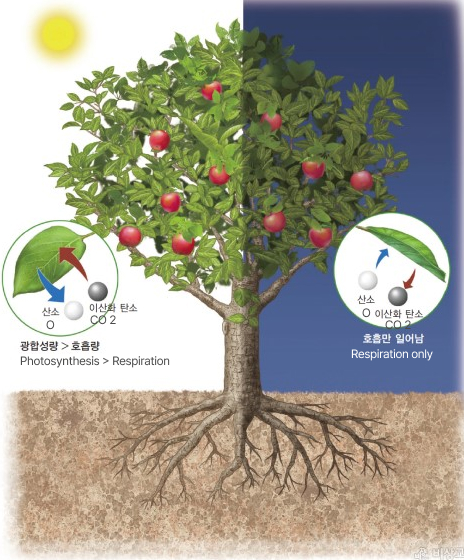
식물체에서의 기체 교환
Gas Exchange in Plants
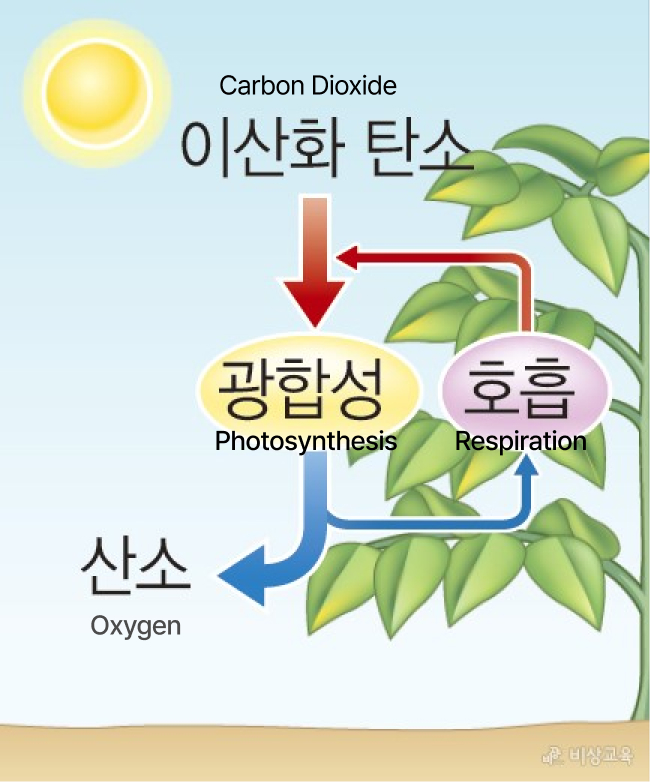
식물체의 기체 교환(낮)
Gas Exchange in Plants (daytime)
광합성량 > 호흡량, 이산화 탄소 흡수, 산소 방출
Photosynthesis > Respiration, carbon dioxide uptake, oxygen release
낮에는 빛이 있어 광합성이 활발하게 일어납니다. (광합성량 > 호흡량)
Photosynthesis is active during the day because there is light (photosynthesis > respiration).
광합성량이 호흡량보다 많아 광합성으로 소모되는 이산화 탄소의 양이 호흡으로 방출되는 양보다 많습니다.
Photosynthesis is greater than respiration, so the amount of carbon dioxide consumed by photosynthesis is greater than the amount released by respiration.
따라서 식물은 낮에 이산화 탄소를 흡수하고 산소를 방출합니다.
So plants absorb carbon dioxide and release oxygen during the day.
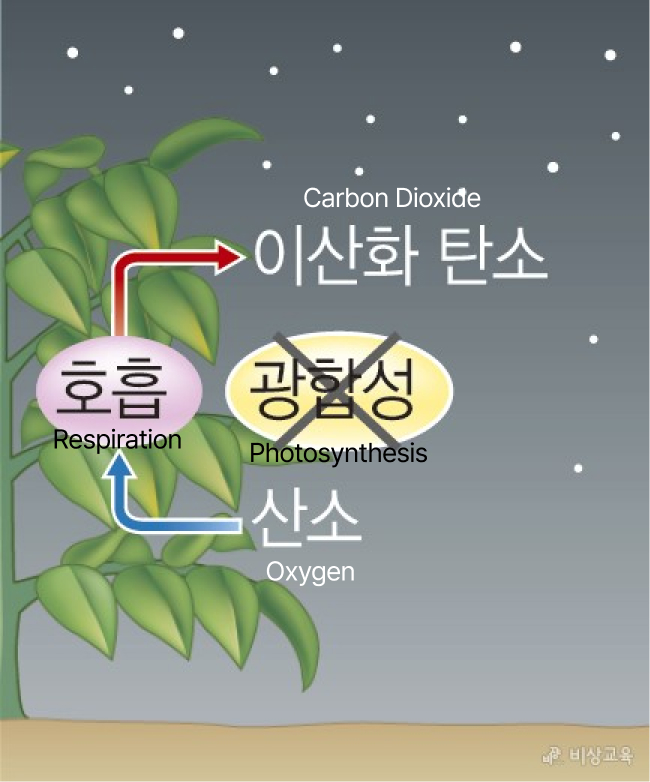
식물체의 기체 교환(밤)
Gas Exchange in Plants (night)
광합성량 = 0, 산소 흡수, 이산화 탄소 방출
Photosynthesis = 0, oxygen absorbed, carbon dioxide released
밤에는 빛이 없어 호흡만 일어납니다.
Only breathing occurs at night as there is no light.
따라서 식물은 밤에 산소를 흡수하고 이산화 탄소를 방출합니다.
So plants absorb oxygen and release carbon dioxide at night.

식물체의 기체 교환(아침과 저녁)
Gas Exchange in Plants (Morning and evening)
광합성량 = 호흡량
Photosynthesis = Respiration
광합성으로 만들어진 산소는 모두 호흡에 이용되고, 호흡으로 만들어진 이산화 탄소는 모두 광합성에 이용됩니다. (광합성량 = 호흡량)
All of the oxygen produced by photosynthesis is used for respiration, and all of the carbon dioxide produced by respiration is used for photosynthesis. (Photosynthesis = respiration)
외관상 기체의 출입이 없습니다.
Apparently, there are no gas entries or exits.
이상적인 토양은 45%의 광물과 5%의 유기물 및 50%의 기공공간이 필요하며 기공공간은 식물에게 필요한 물과 산소를 공급하고 산소는 우리가 호흡하는 대기중에 약 21% 정도 존재합니다.
Ideal soil is 45% minerals, 5% organic matter, and 50% pore space, which provides plants with the water and oxygen they need, and oxygen is about 21% of the air we breathe.
뿌리호흡은 주로 밤에 일어나고 토양 내 산소 수준이 낮을 경우 뿌리의 성장은 적어지고 뿌리의 생존 가능성이 낮아지므로 토양(배지) 내에는 수분과 산소의 균형이 필요합니다.
Root respiration occurs mostly at night, and low oxygen levels in the soil result in less root growth and lower root viability, so a balance of moisture and oxygen is needed within the soil (medium).
한번에 물을 과하게 주거나 배수 불량은 토양 내 큰 구멍을 차단하므로 산소가 뿌리로 이동하고 이산화 탄소를 공기중으로 배출하는 것을 막아 식물성장을 막거나 죽을 수 있습니다.
Overwatering or poor drainage at one time can block large holes in the soil, preventing oxygen from moving to the roots and carbon dioxide from being released into the air, which can stunt or kill plant growth.